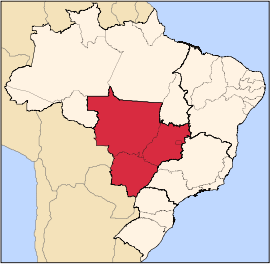Brazil Capital
What is the Capital of Brazil?
Central West Region Brasil

Brazil capital city is Brasilia, which is both a city and a Federal District, located in the central-west region.
Brazil is geographically divided into five regions, North, Northeast, Central-West, South and Southeast. The country comprise
of twenty-six states in addition to one Federal District, which
is Brasilia, the capital. Of the 26 other states, nine make up Brazil northeast.
As you can see from the map of Brasil, Brazil capital and federal district is surrounded by the Brazilian state of Goiás, with the exception of a short boundary with Minas Gerais. The Brazilian capital has a population in the region of 2,455,903 according to the 2007 census and is the
seat of the Brazilian government.
The capitol of Brazil, which is listed as a World Heritage Site by UNESCO, is also home to the presidential palace - Palácio da Alvorada, the Brazilian Parliament and Brazil's Supreme Court. Brasília city is also known as the "Capital da Esperança" - meaning, "The Capital of Hope", a phrase
coined by the French author André Malraux.
Although the architect's original urban concept and design for the construction of Brasilia was that of a cross to symbolise possession, It is said by many that when you look down on Brasilia from the air, its shape resembles that of an airplane while others see the shape in terms of a bird with outstretched wings.
Background info on the capital city of Brazil
From 1763 to 1960, the southeastern coastal city of Rio de Janeiro was the capital city of Brazil.
Back in 1823, José Bonifácio de Andrada e Silva, a counselor and minister to Dom Pedro I, suggested the name 'Brasilia'
in a bill presented to the Brazilian assembly to build a new Brazil capital city.
The construction of the Brasil capital Brasilia, was ordered by President Jescelino Kubitschek, who fulfilled an article of the Country's constitution, namely, that Brazil's capital and federal city should be moved from Rio de Janeiro to the center of Brasil. A determining factor of the early article was for a new capital city that was away from the sea and safe from invaders. The main urban planner, chief architect and landscape designer were Lúcio Costa, Oscar Niemeyer and Roberto Burle Marx, respectively.
Construction commenced in 1956. The rationale behind the Brazilian government's relocation at this time being, that Brasilia's geographical central location would be a more regionally neutral federal capital and that by moving inland, more people would follow and populate the then, isolated region thus integrating the entire
territory of Brazil.
People from all over the country were recruited to help with the
building of the Brazil capital city and especially people from Northeast Brazil. Brazilia formally became the capital of Brazil in 1960, when it was officially inaugurated. Today, Brasilia, Brazil's capital city is considered a world reference for urban planning.
With its pioneering positioning of residential buildings around expansive urban areas and with the city being built around large avenues that divide it into sectors, the design plan has captured the imagination and stimulated much debate on 20th century city living.
Brasilia Brazil
The cosmopolitan national city of Brasil, with futuristic design. Brasilia is the seat of government, as well as
being host to major businesses.Some interesting facts about Brasilia...
Return From Brazil Capital To Brazil Travel Notheast Home Page